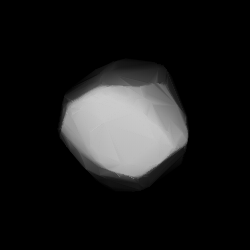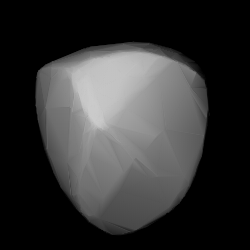Related Research Articles

2001 Einstein is a bright Hungaria asteroid from the innermost region of the asteroid belt. It was discovered by Swiss astronomer Paul Wild at Zimmerwald Observatory near Bern, Switzerland, on 5 March 1973. The X-type asteroid (Xe) has a rotation period of 5.5 hours and measures approximately 5 kilometers in diameter. It is named after physicist Albert Einstein (1879–1955).
3043 San Diego, provisional designation 1982 SA, is a stony Hungaria asteroid and slow rotator from the inner regions of the asteroid belt, approximately 4.7 kilometers in diameter.
4031 Mueller, provisional designation 1985 CL, is a Hungaria asteroid from the inner regions of the asteroid belt, approximately 4 kilometers in diameter. It was discovered on 12 February 1985, by American astronomer Carolyn Shoemaker at Palomar Observatory, California, and named after astronomer Jean Mueller.

1103 Sequoia is a bright Hungaria asteroid from the innermost region of the asteroid belt, approximately 7 kilometers in diameter. It was discovered on 9 November 1928, by German astronomer Walter Baade at the Bergedorf Observatory in Hamburg, Germany, who named it after the Sequoia National Park located in California.
3225 Hoag, provisional designation 1982 QQ, is a dynamical Hungaria asteroid from the innermost regions of the asteroid belt, approximately 5.5 kilometers in diameter. It was discovered on 20 August 1982, by American astronomer couple Carolyn and Eugene Shoemaker at the Palomar Observatory in California. The stony S/L-type asteroid has a short rotation period of 2.37 hours. It was named for American astronomer Arthur Hoag.
5175 Ables, provisional designation 1988 VS4, is a bright Hungaria asteroid from the inner regions of the asteroid belt, approximately 5 kilometers in diameter. It was discovered by American astronomers Carolyn and Eugene Shoemaker at the U.S. Palomar Observatory, California, on 4 November 1988. It was named after American astronomer Harold Ables.
1919 Clemence, provisional designation 1971 SA, is a bright Hungaria asteroid and suspected tumbler from the inner regions of the asteroid belt, approximately 4 kilometers in diameter. It was discovered on 16 September 1971, by American astronomer James Gibson together with Argentine astronomer Carlos Cesco at the Yale-Columbia Southern Station at Leoncito Astronomical Complex in Argentina. It is named after astronomer Gerald Clemence.
6296 Cleveland, provisional designation 1988 NC, is a Hungaria asteroid from the innermost regions of the asteroid belt, approximately 3.5 kilometers in diameter. It was discovered on 12 July 1988, by American astronomer Eleanor Helin at the Palomar Observatory in California. The presumed E-type asteroid has a long rotation period of 30.8 hours and possibly an elongated shape. It was named for the city of Cleveland in the U.S. state of Ohio.
3353 Jarvis, or by its provisional designation, 1981 YC, is a carbonaceous Hungaria asteroid, slow rotator and suspected tumbler from the inner regions of the asteroid belt, approximately 10 kilometers in diameter.
5899 Jedicke, provisional designation 1986 AH, is a binary Hungaria asteroid approximately 3 kilometers in diameter. It was discovered on 9 January 1986, by American astronomer Carolyn Shoemaker at Palomar Observatory, and named after the members of the Canadian Jedicke family.
1355 Magoeba, provisional designation 1935 HE, is a Hungaria asteroid and a suspected contact-binary from the innermost regions of the asteroid belt, approximately 5 kilometers in diameter. It was discovered on 30 April 1935, by English-born, South African astronomer Cyril Jackson at the Johannesburg Observatory in South Africa. The asteroid is named for Magoeba, a tribal chief in the South African Transvaal Province.

3169 Ostro, provisional designation 1981 LA, is a Hungaria family asteroid from the innermost regions of the asteroid belt, approximately 5 kilometers in diameter.
5426 Sharp, provisional designation 1985 DD, is a bright Hungaria asteroid and suspected binary system from the inner regions of the asteroid belt, approximately 2–3 kilometers in diameter. It was discovered on 16 February 1985, by American astronomer Carolyn Shoemaker at Palomar Observatory, California, and named after American geologist Robert P. Sharp.
2047 Smetana, provisional designation 1971 UA1, is a bright Hungaria asteroid and synchronous binary system from the innermost regions of the asteroid belt, approximately 3.5 kilometers in diameter. It was discovered on 26 October 1971, by Czech astronomer Luboš Kohoutek at Bergedorf Observatory in Hamburg, Germany. The asteroid was named after Czech composer Bedřich Smetana. Its sub-kilometer sized minor-planet moon was discovered in 2012.
For other uses, see Steel (disambiguation).

4765 Wasserburg (prov. designation: 1986 JN1) is a bright Hungaria asteroid, suspected binary system and asteroid pair from the innermost regions of the asteroid belt, approximately 3 kilometers (1.9 miles) in diameter. It was discovered on 5 May 1986, by American astronomer Carolyn Shoemaker at Palomar Observatory, and later named after geologist Gerald J. Wasserburg.
4440 Tchantchès, provisional designation 1984 YV, is a rather elongated Hungaria asteroid and a possible binary system from the inner regions of the asteroid belt, approximately 3 kilometers in diameter.

1600 Vyssotsky, provisional designation 1947 UC, is a rare-type Hungaria asteroid and suspected interloper from the inner regions of the asteroid belt, approximately 7 kilometers in diameter. It was discovered on 22 October 1947, by American astronomer Carl Wirtanen at Lick Observatory in California, United States. It was named after astronomer Alexander Vyssotsky.
(6382) 1988 EL is a stony Hungaria asteroid from the inner regions of the asteroid belt, approximately 5 kilometers in diameter. It was discovered on 14 March 1988, by American astronomer Jeffrey Alu at the U.S. Palomar Observatory, California.
8026 Johnmckay, provisional designation 1991 JA1, is a binary Hungaria asteroid and very slow rotator from the inner regions of the asteroid belt, approximately 2 kilometers in diameter. It was discovered on 8 May 1991, by American astronomer Eleanor Helin at the U.S. Palomar Observatory, California, and later named for NASA test pilot John B. McKay.
References
- 1 2 3 4 5 "JPL Small-Body Database Browser: 4868 Knushevia (1989 UN2)" (2016-11-30 last obs.). Jet Propulsion Laboratory. Archived from the original on 16 September 2020. Retrieved 7 July 2017.
- 1 2 3 Schmadel, Lutz D. (2007). "(4868) Knushevia". Dictionary of Minor Planet Names – (4868) Knushevia. Springer Berlin Heidelberg. p. 420. doi:10.1007/978-3-540-29925-7_4762. ISBN 978-3-540-00238-3.
- 1 2 "4868 Knushevia (1989 UN2)". Minor Planet Center. Retrieved 7 July 2017.
- 1 2 3 4 5 6 "LCDB Data for (4868) Knushevia". Asteroid Lightcurve Database (LCDB). Retrieved 7 July 2017.
- 1 2 3 Warner, Brian D.; Stephens, Robert D. (July 2015). "The Hungaria Asteroid 4868 Knushevia: A Possible Binary". The Minor Planet Bulletin. 42 (3): 188–189. Bibcode:2015MPBu...42..188W. ISSN 1052-8091. PMID 32455357 . Retrieved 7 July 2017.
- 1 2 3 4 Mainzer, A.; Grav, T.; Masiero, J.; Hand, E.; Bauer, J.; Tholen, D.; et al. (November 2011). "NEOWISE Studies of Spectrophotometrically Classified Asteroids: Preliminary Results". The Astrophysical Journal. 741 (2): 25. arXiv: 1109.6407 . Bibcode:2011ApJ...741...90M. doi:10.1088/0004-637X/741/2/90.
- 1 2 3 Masiero, Joseph R.; Mainzer, A. K.; Grav, T.; Bauer, J. M.; Cutri, R. M.; Dailey, J.; et al. (November 2011). "Main Belt Asteroids with WISE/NEOWISE. I. Preliminary Albedos and Diameters". The Astrophysical Journal. 741 (2): 20. arXiv: 1109.4096 . Bibcode:2011ApJ...741...68M. doi:10.1088/0004-637X/741/2/68 . Retrieved 7 July 2017.
- 1 2 Warner, Brian D. (January 2009). "Asteroid Lightcurve Analysis at the Palmer Divide Observatory: 2008 May - September". The Minor Planet Bulletin. 36 (1): 7–13. Bibcode:2009MPBu...36....7W. ISSN 1052-8091 . Retrieved 7 July 2017.
- 1 2 Warner, Brian D. (July 2010). "Asteroid Lightcurve Analysis at the Palmer Divide Observatory: 2009 December - 2010 March". The Minor Planet Bulletin. 37 (3): 112–118. Bibcode:2010MPBu...37..112W. ISSN 1052-8091 . Retrieved 7 July 2017.
- 1 2 Warner, Brian D.; Higgins, David; Pravec, Petr; Harris, Alan W. (April 2012). "The Enigmatic Hungaria Asteroid 4868 Knushevia". The Minor Planet Bulletin. 39 (2): 82–83. Bibcode:2012MPBu...39...82W. ISSN 1052-8091 . Retrieved 7 July 2017.
- ↑ Veres, Peter; Jedicke, Robert; Fitzsimmons, Alan; Denneau, Larry; Granvik, Mikael; Bolin, Bryce; et al. (November 2015). "Absolute magnitudes and slope parameters for 250,000 asteroids observed by Pan-STARRS PS1 - Preliminary results". Icarus. 261: 34–47. arXiv: 1506.00762 . Bibcode:2015Icar..261...34V. doi:10.1016/j.icarus.2015.08.007 . Retrieved 7 July 2017.
- ↑ "MPC/MPO/MPS Archive". Minor Planet Center. Retrieved 7 July 2017.